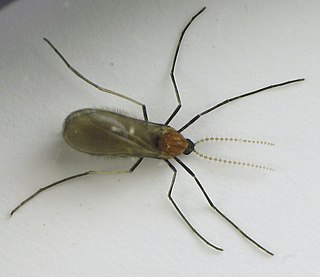
Cecidomyiidae is a family of flies known as gall midges or gall gnats. As the name implies, the larvae of most gall midges feed within plant tissue, creating abnormal plant growths called galls. Cecidomyiidae are very fragile small insects usually only 2–3 mm (0.079–0.118 in) in length; many are less than 1 mm (0.039 in) long. They are characterised by hairy wings, unusual in the order Diptera, and have long antennae. Some Cecidomyiids are also known for the strange phenomenon of paedogenesis in which the larval stage reproduces without maturing first. In some species, the daughter larvae consume the mother, while in others, reproduction occurs later on in the egg or pupa.

The Cecidomyiinae, commonly known as gall midges or gall gnats, is the largest subfamily in Cecidomyiidae with over 600 genera and more than 5000 described species. This subfamily is best known for its members that induce galls on plants, but there are also many species that are fungivores, parasitoids, or predators as maggots.

Rhopalomyia pedicellata is a species of gall midges, insects in the family Cecidomyiidae.

Rhopalomyia is a genus of gall midges, insects in the family Cecidomyiidae. There are at least 267 described species in Rhopalomyia. Most species in this genus induce galls on plants in the Asteraceae. This genus has a cosmopolitan distribution. Rhopalomyia was first established by Ewald Heinrich Rübsaamen in 1892.
Rhopalomyia baccharis, the coyote brush twisted stem gall midge, is a species of gall midges, insects in the family Cecidomyiidae.

Rhopalomyia pomum, the sponge gall midge, is a species of gall midges, insects in the family Cecidomyiidae. The midges form leaf galls on Great Basin sagebrush.

Rhopalomyia anthophilathe Downy Flower Gall Midgeis a species of gall midges, insects in the family Cecidomyiidae. It induces galls on the host Solidago altissima across much of North America.

Rhopalomyia californica, the coyote brush bud gall midge, is a species of gall midges, insects in the family Cecidomyiidae.

Rhopalomyia solidaginis, the goldenrod bunch gall, is a species of gall midges, insects in the family Cecidomyiidae The galls of this species have the following host species of goldenrods:Solidago altissima, Solidago canadensis, Solidago rugosa They have been found across eastern North American.

Rhopalomyia lobata is a species of gall midges, insects in the family Cecidomyiidae. The galls form on stems and buds of Euthamia graminifolia the grass-leaved goldenrod. The species ranges from Florida to Mississippi, north to Oregon, New England and most of Canada.

Rhopalomyia audibertiae, the sage leaf gall midge, is a species of gall midges, insects in the family Cecidomyiidae.
Rhopalomyia chrysothamni is a species of gall midges, insects in the family Cecidomyiidae. The midge causes very small, conical-tubular stem galls on rubber rabbitbrush [Ericameria nauseosa].

Olpodiplosis is a monotypic genus of gall midges, insects in the family Cecidomyiidae. The only described species is Olpodiplosis helianthi.

Rhopalomyia hirtipes is a species of gall midges, insects in the family Cecidomyiidae. They are found in the eastern part of North American on buds and stems of Solidago juncea
Rhopalomyia grossulariae, the gooseberry gall midge, is a species of gall midges, insects in the family Cecidomyiidae.
Rhopalomyia ericameriae is a species of gall midges, insects in the family Cecidomyiidae.

Rhopalomyia clarkei is a species of gall midges, insects in the family Cecidomyiidae. The larvae induce galls on two hosts: Solidago altissima and Solidago rugosa and are found in north-eastern and north central North America.
Rhopalomyia lateriflori is a species of gall midge, insects in the family Cecidomyiidae.
Rhopalomyia astericaulis is a species of gall midges, insects in the family Cecidomyiidae.

Rhopalomyia capitata, the giant goldenrod bunch gall, is a species of gall midge in the family Cecidomyiidae. It is found across North America. They have been collected from Solidago canadensis, Solidago gigantea, and Solidago leavenworthiigallormers species page













